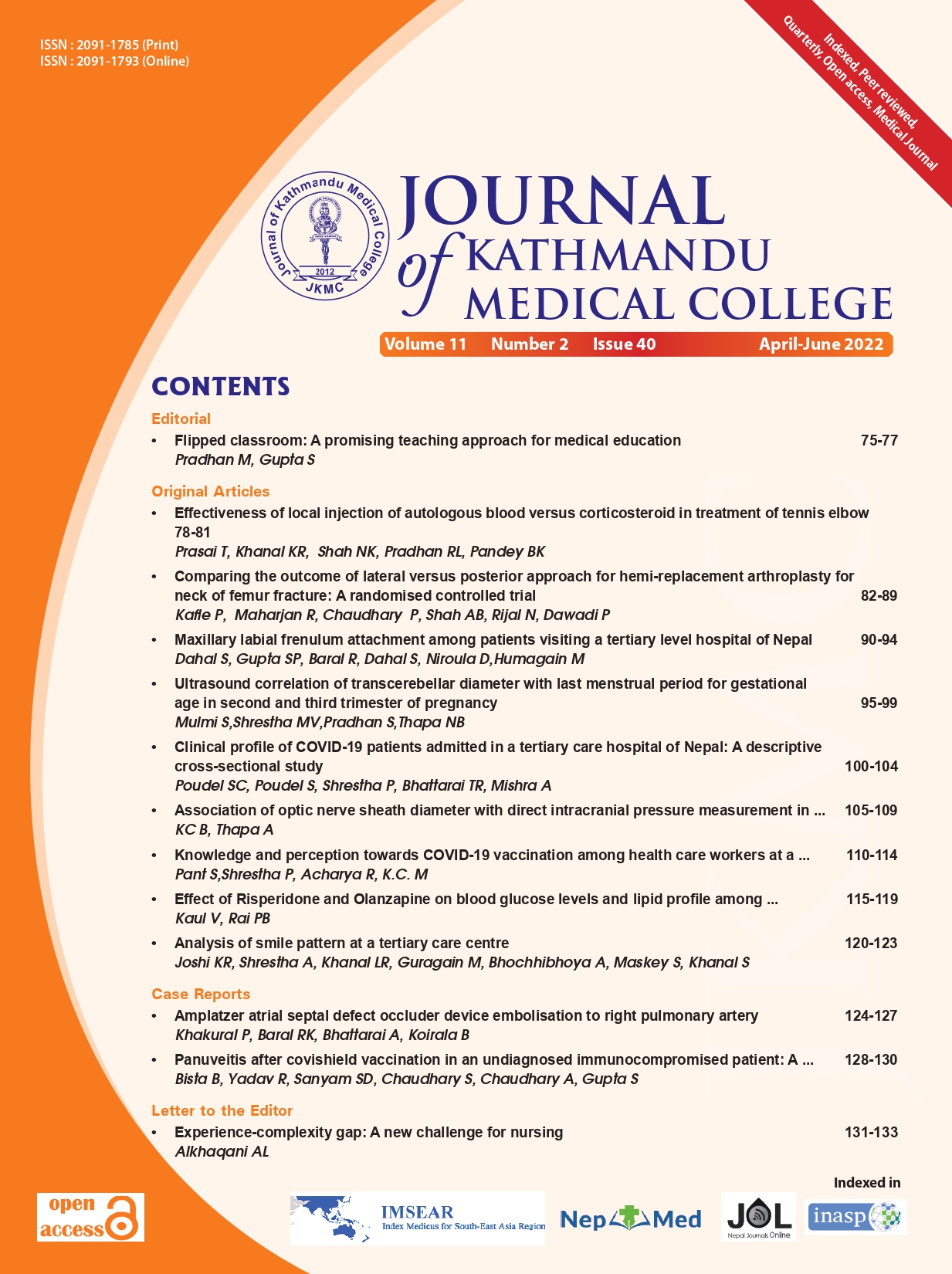Comparing the outcome of lateral versus posterior approach for hemi-replacement arthroplasty for neck of femur fracture: A randomised controlled trial
DOI:
https://doi.org/10.3126/jkmc.v11i2.48667Keywords:
Arthroplasty, Outcome, RandomisationAbstract
Background: Among commonly used approaches, posterior approach (Moore’s) results in better regain of function as it require less muscle dissection, while the lateral approach (Hardinge’s) has a lower risk of dislocation.
Objectives: To compare the functional outcome between lateral and posterior approaches for hemiarthroplasty.
Methods: This parallel design randomised controlled trial of equivalence (allocation ratio 1:1) was conducted in the department of orthopaedics, BP Koirala Institute of Health Sciences with institutional ethical clearance. Fifty eligible patients of >60 years with isolated traumatic displaced neck of femur fracture, presenting during study period from September 2017 to August 2019, were conveniently recruited and randomly allocated by using computerised Excel random number generation technique to undergo hemi-replacement arthroplasty either by lateral approach (N = 25) or by posterior approach (N = 25) and were evaluated at six weeks, three months, six months, and twelve months. Final statistical analysis was done using SPSS v.20 software among 45 patients because four deceased and one was lost to follow-up. The p-value <0.05 was considered statistically significant.
Results: The functional outcome as measured by the Modified Harris Hip score at one year was 83.78 ± 5.89 for lateral approach and 80.40 ± 7.56 for posterior approach group (p = 0.102). The hip pain, mean blood loss, operative time, and prothesis size was similar between the two approaches.
Conclusion: The study showed that there was no significant difference between the two approaches for hemireplacement arthroplasty in terms of mean operating time, hip pain, and functional outcomes.
Downloads
References
Korhonen N, Niemi S, Parkkari J, Sievänen H, Palvanen M, Kannus P. Continuous decline in incidence of hip fracture: Nationwide statistics from Finland between 1970 and 2010. Osteoporos Int. 2013;24(5):1599–603.
Singer BR, McLauchlan GJ, Robinson CM, Christie J. Epidemiology of fractures in 15 000 adults: The influence of age and gender. J Bone Jt Surg. 1998;80(2):243–8.
Dennison E, Mohamed MA, Cooper C. Epidemiology of Osteoporosis. Rheum Dis Clin North Am. 2006;32:617–29.
Court-Brown CM, Aitken SA, Forward D, O’Toole RV. The epidemiology of fractures. In: Buchholz RW, Court-Brown CM, Heckman JD, Tornetta P E. Rockwood and green’s fractures in adults. 7th ed Philadelphia Lippincott Williams Wilkins. 2010;53–84.
Weinlein JC. Campbell’s Operative Orthopaedics. S. Terry Canale, James H. Beaty, editor. Elsevier Ltd; 2012. 2725–2737 .
Downloads
Published
How to Cite
Issue
Section
License
Copyright © Journal of Kathmandu Medical College
The ideas and opinions expressed by authors or articles summarized, quoted, or published in full text in this journal represent only the opinions of the authors and do not necessarily reflect the official policy of Journal of Kathmandu Medical College or the institute with which the author(s) is/are affiliated, unless so specified.
Authors convey all copyright ownership, including any and all rights incidental thereto, exclusively to JKMC, in the event that such work is published by JKMC. JKMC shall own the work, including 1) copyright; 2) the right to grant permission to republish the article in whole or in part, with or without fee; 3) the right to produce preprints or reprints and translate into languages other than English for sale or free distribution; and 4) the right to republish the work in a collection of articles in any other mechanical or electronic format.




